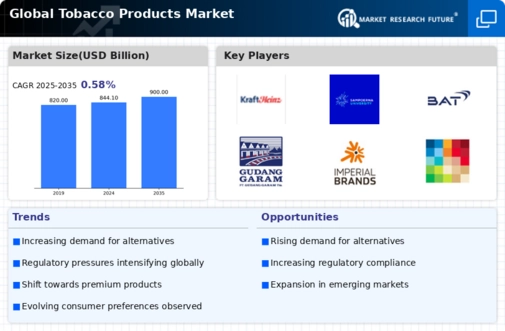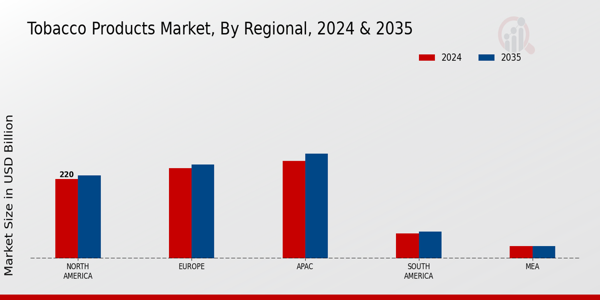-
EXECUTIVE SUMMARY
-
Key Findings
-
Market Segmentation
-
Challenges and Opportunities
-
Future Outlook
-
MARKET INTRODUCTION
-
Scope of the study
- Research Objective
- Limitations
-
RESEARCH METHODOLOGY
-
Data Mining
-
Secondary Research
- Primary Interviews and
- Breakdown
-
Forecasting Model
-
Market Size Estimation
- Top-Down Approach
-
Data Triangulation
-
MARKET DYNAMICS
-
Overview
-
Drivers
-
Restraints
-
MARKET FACTOR ANALYSIS
-
Value chain Analysis
- Bargaining
- Bargaining Power of Buyers
- Threat of New Entrants
- Threat of Substitutes
-
COVID-19 Impact Analysis
- Market Impact Analysis
- Regional Impact
-
TOBACCO
-
Cigars
-
Chewing Tobacco
-
TOBACCO PRODUCTS MARKET, BY
-
Flavored
-
Non-Flavored
-
Roll-Your-Own
-
TOBACCO
-
Online Stores
-
Supermarkets
-
TOBACCO
-
Gender
-
Income Level
-
TOBACCO
-
US
- Canada
-
Europe
- Germany
- France
- Italy
- Spain
-
APAC
- China
- Japan
- South Korea
- Thailand
- Indonesia
-
South America
- Brazil
- Argentina
- Rest of South America
- GCC Countries
- South Africa
-
COMPETITIVE LANDSCAPE
-
Overview
-
Competitive
-
Market share Analysis
-
Major Growth Strategy in the Tobacco Products Market
-
Competitive Benchmarking
-
Leading Players in Terms of Number of Developments in
-
Key
-
Major Players Financial
- Sales and Operating Income
- Major Players R&D Expenditure.
-
COMPANY PROFILES
-
China National Tobacco Corporation
- Financial Overview
- Key Developments
- SWOT Analysis
-
Kraft Heinz
- Financial Overview
- Key Developments
- SWOT Analysis
-
Sampoerna
- Financial Overview
- Key Developments
- SWOT Analysis
-
Japan Tobacco International
- Financial Overview
- Products Offered
- SWOT Analysis
- Key Strategies
- Products Offered
- Key Developments
- Key Strategies
-
0050
- Products Offered
- Key Developments
- Key Strategies
-
Philip Morris International
- Products Offered
- Key Developments
- Key Strategies
-
British American Tobacco
- Products Offered
- Key Developments
- Key Strategies
-
PT Gudang Garam Tbk
- Products Offered
- Key Developments
- Key Strategies
-
Imperial Brands
- Products Offered
- Key Developments
- Key Strategies
-
Altria Group
- Products Offered
- Key Developments
- Key Strategies
-
Swedish Match
- Products Offered
- Key Developments
- Key Strategies
-
ITC Limited
- Products Offered
- Key Developments
- Key Strategies
-
Reynolds American
- Products Offered
- Key Developments
- Key Strategies
-
APPENDIX
-
References
-
Related Reports
-
NORTH AMERICA TOBACCO
-
NORTH AMERICA TOBACCO PRODUCTS
-
NORTH AMERICA TOBACCO PRODUCTS
-
NORTH AMERICA TOBACCO PRODUCTS
-
NORTH AMERICA TOBACCO PRODUCTS MARKET SIZE ESTIMATES
-
US TOBACCO PRODUCTS MARKET SIZE ESTIMATES & FORECAST, BY PRODUCT TYPE, 2019-2035
-
US TOBACCO PRODUCTS
-
US TOBACCO PRODUCTS MARKET
-
US TOBACCO PRODUCTS MARKET
-
US TOBACCO PRODUCTS MARKET SIZE ESTIMATES & FORECAST,
-
CANADA TOBACCO PRODUCTS
-
CANADA TOBACCO PRODUCTS MARKET
-
CANADA TOBACCO PRODUCTS MARKET
-
CANADA TOBACCO PRODUCTS MARKET SIZE ESTIMATES &
-
EUROPE TOBACCO PRODUCTS MARKET SIZE ESTIMATES & FORECAST, BY PRODUCT TYPE,
-
EUROPE TOBACCO PRODUCTS
-
GERMANY TOBACCO PRODUCTS MARKET SIZE ESTIMATES &
-
GERMANY TOBACCO PRODUCTS MARKET SIZE ESTIMATES & FORECAST, BY CONSUMPTION
-
GERMANY TOBACCO PRODUCTS
-
UK TOBACCO PRODUCTS MARKET SIZE ESTIMATES & FORECAST,
-
UK TOBACCO PRODUCTS MARKET SIZE ESTIMATES & FORECAST, BY CONSUMPTION METHOD,
-
UK TOBACCO PRODUCTS
-
FRANCE TOBACCO PRODUCTS MARKET SIZE ESTIMATES &
-
FRANCE TOBACCO PRODUCTS MARKET SIZE ESTIMATES & FORECAST, BY CONSUMPTION
-
FRANCE TOBACCO PRODUCTS
-
RUSSIA TOBACCO PRODUCTS MARKET SIZE ESTIMATES &
-
RUSSIA TOBACCO PRODUCTS MARKET SIZE ESTIMATES & FORECAST, BY CONSUMPTION
-
RUSSIA TOBACCO PRODUCTS
-
ITALY TOBACCO PRODUCTS MARKET SIZE ESTIMATES &
-
ITALY TOBACCO PRODUCTS MARKET SIZE ESTIMATES & FORECAST, BY CONSUMPTION
-
ITALY TOBACCO PRODUCTS
-
SPAIN TOBACCO PRODUCTS MARKET SIZE ESTIMATES &
-
SPAIN TOBACCO PRODUCTS MARKET SIZE ESTIMATES & FORECAST, BY CONSUMPTION
-
SPAIN TOBACCO PRODUCTS
-
REST OF EUROPE TOBACCO PRODUCTS MARKET SIZE ESTIMATES
-
REST OF EUROPE TOBACCO PRODUCTS MARKET SIZE ESTIMATES & FORECAST, BY CONSUMPTION
-
APAC TOBACCO PRODUCTS
-
APAC TOBACCO PRODUCTS MARKET
-
APAC TOBACCO PRODUCTS MARKET
-
APAC TOBACCO PRODUCTS MARKET SIZE ESTIMATES &
-
CHINA TOBACCO PRODUCTS MARKET SIZE ESTIMATES & FORECAST, BY PRODUCT TYPE,
-
CHINA TOBACCO PRODUCTS
-
INDIA TOBACCO PRODUCTS MARKET SIZE ESTIMATES &
-
INDIA TOBACCO PRODUCTS MARKET SIZE ESTIMATES & FORECAST, BY CONSUMPTION
-
INDIA TOBACCO PRODUCTS
-
JAPAN TOBACCO PRODUCTS MARKET SIZE ESTIMATES &
-
JAPAN TOBACCO PRODUCTS MARKET SIZE ESTIMATES & FORECAST, BY CONSUMPTION
-
JAPAN TOBACCO PRODUCTS
-
SOUTH KOREA TOBACCO PRODUCTS MARKET SIZE ESTIMATES
-
SOUTH KOREA TOBACCO PRODUCTS MARKET SIZE ESTIMATES & FORECAST, BY CONSUMPTION
-
THAILAND TOBACCO PRODUCTS
-
THAILAND TOBACCO PRODUCTS
-
THAILAND TOBACCO PRODUCTS
-
THAILAND TOBACCO PRODUCTS
-
THAILAND TOBACCO PRODUCTS MARKET SIZE ESTIMATES &
-
INDONESIA TOBACCO PRODUCTS MARKET SIZE ESTIMATES & FORECAST, BY PRODUCT
-
REST OF APAC TOBACCO
-
REST OF APAC TOBACCO PRODUCTS
-
REST OF APAC TOBACCO PRODUCTS
-
REST OF APAC TOBACCO PRODUCTS
-
REST OF APAC TOBACCO PRODUCTS MARKET SIZE ESTIMATES
-
SOUTH AMERICA TOBACCO PRODUCTS MARKET SIZE ESTIMATES & FORECAST, BY PRODUCT
-
BRAZIL TOBACCO PRODUCTS
-
BRAZIL TOBACCO PRODUCTS MARKET
-
BRAZIL TOBACCO PRODUCTS MARKET
-
BRAZIL TOBACCO PRODUCTS MARKET SIZE ESTIMATES &
-
MEXICO TOBACCO PRODUCTS MARKET SIZE ESTIMATES & FORECAST, BY PRODUCT TYPE,
-
MEXICO TOBACCO PRODUCTS
-
ARGENTINA TOBACCO PRODUCTS MARKET SIZE ESTIMATES
-
ARGENTINA TOBACCO PRODUCTS MARKET SIZE ESTIMATES & FORECAST, BY CONSUMPTION
-
REST OF SOUTH AMERICA
-
REST OF SOUTH AMERICA
-
REST OF SOUTH AMERICA
-
MEA TOBACCO PRODUCTS
-
MEA TOBACCO PRODUCTS MARKET
-
MEA TOBACCO PRODUCTS MARKET
-
MEA TOBACCO PRODUCTS MARKET SIZE ESTIMATES &
-
GCC COUNTRIES TOBACCO PRODUCTS MARKET SIZE ESTIMATES & FORECAST, BY PRODUCT
-
ACQUISITION/PARTNERSHIP
-
MARKET SYNOPSIS
-
NORTH AMERICA TOBACCO PRODUCTS MARKET ANALYSIS
-
US TOBACCO PRODUCTS MARKET ANALYSIS BY PRODUCT TYPE
-
US TOBACCO PRODUCTS MARKET
-
US TOBACCO PRODUCTS MARKET ANALYSIS BY DEMOGRAPHIC
-
US TOBACCO PRODUCTS MARKET ANALYSIS BY REGIONAL
-
CANADA TOBACCO PRODUCTS MARKET ANALYSIS BY PRODUCT TYPE
-
CANADA TOBACCO PRODUCTS MARKET ANALYSIS BY CONSUMPTION METHOD
-
CANADA TOBACCO PRODUCTS MARKET ANALYSIS BY DISTRIBUTION
-
CANADA TOBACCO PRODUCTS
-
EUROPE TOBACCO PRODUCTS MARKET ANALYSIS
-
GERMANY TOBACCO PRODUCTS MARKET ANALYSIS BY PRODUCT TYPE
-
GERMANY TOBACCO PRODUCTS MARKET ANALYSIS BY CONSUMPTION METHOD
-
GERMANY TOBACCO PRODUCTS MARKET ANALYSIS BY DISTRIBUTION
-
GERMANY TOBACCO PRODUCTS
-
UK TOBACCO PRODUCTS MARKET ANALYSIS BY PRODUCT TYPE
-
UK TOBACCO PRODUCTS MARKET ANALYSIS BY CONSUMPTION METHOD
-
UK TOBACCO PRODUCTS MARKET ANALYSIS BY DISTRIBUTION
-
UK TOBACCO PRODUCTS
-
FRANCE TOBACCO PRODUCTS MARKET ANALYSIS BY PRODUCT TYPE
-
FRANCE TOBACCO PRODUCTS MARKET ANALYSIS BY CONSUMPTION METHOD
-
FRANCE TOBACCO PRODUCTS MARKET ANALYSIS BY DISTRIBUTION
-
FRANCE TOBACCO PRODUCTS
-
RUSSIA TOBACCO PRODUCTS MARKET ANALYSIS BY PRODUCT TYPE
-
RUSSIA TOBACCO PRODUCTS MARKET ANALYSIS BY CONSUMPTION METHOD
-
RUSSIA TOBACCO PRODUCTS MARKET ANALYSIS BY DISTRIBUTION
-
RUSSIA TOBACCO PRODUCTS
-
ITALY TOBACCO PRODUCTS MARKET ANALYSIS BY PRODUCT TYPE
-
ITALY TOBACCO PRODUCTS MARKET ANALYSIS BY CONSUMPTION METHOD
-
ITALY TOBACCO PRODUCTS MARKET ANALYSIS BY DISTRIBUTION
-
ITALY TOBACCO PRODUCTS
-
SPAIN TOBACCO PRODUCTS MARKET ANALYSIS BY PRODUCT TYPE
-
SPAIN TOBACCO PRODUCTS MARKET ANALYSIS BY CONSUMPTION METHOD
-
SPAIN TOBACCO PRODUCTS MARKET ANALYSIS BY DISTRIBUTION
-
SPAIN TOBACCO PRODUCTS
-
REST OF EUROPE TOBACCO PRODUCTS MARKET ANALYSIS BY PRODUCT TYPE
-
REST OF EUROPE TOBACCO PRODUCTS MARKET ANALYSIS
-
REST OF EUROPE TOBACCO
-
REST OF EUROPE TOBACCO PRODUCTS MARKET ANALYSIS BY DEMOGRAPHIC
-
REST OF EUROPE TOBACCO PRODUCTS MARKET ANALYSIS
-
APAC TOBACCO PRODUCTS
-
CHINA TOBACCO PRODUCTS
-
CHINA TOBACCO PRODUCTS MARKET ANALYSIS BY DISTRIBUTION CHANNEL
-
CHINA TOBACCO PRODUCTS MARKET ANALYSIS BY DEMOGRAPHIC
-
CHINA TOBACCO PRODUCTS MARKET
-
INDIA TOBACCO PRODUCTS
-
INDIA TOBACCO PRODUCTS MARKET ANALYSIS BY DISTRIBUTION CHANNEL
-
INDIA TOBACCO PRODUCTS MARKET ANALYSIS BY DEMOGRAPHIC
-
INDIA TOBACCO PRODUCTS MARKET
-
JAPAN TOBACCO PRODUCTS
-
JAPAN TOBACCO PRODUCTS MARKET ANALYSIS BY DISTRIBUTION CHANNEL
-
JAPAN TOBACCO PRODUCTS MARKET ANALYSIS BY DEMOGRAPHIC
-
JAPAN TOBACCO PRODUCTS MARKET
-
SOUTH KOREA TOBACCO
-
SOUTH KOREA TOBACCO PRODUCTS MARKET ANALYSIS BY
-
SOUTH KOREA TOBACCO
-
MALAYSIA TOBACCO PRODUCTS MARKET ANALYSIS BY PRODUCT TYPE
-
MALAYSIA TOBACCO PRODUCTS MARKET ANALYSIS BY CONSUMPTION
-
MALAYSIA TOBACCO PRODUCTS
-
MALAYSIA TOBACCO PRODUCTS MARKET ANALYSIS BY REGIONAL
-
THAILAND TOBACCO PRODUCTS MARKET ANALYSIS BY PRODUCT TYPE
-
THAILAND TOBACCO PRODUCTS MARKET ANALYSIS BY CONSUMPTION
-
THAILAND TOBACCO PRODUCTS
-
THAILAND TOBACCO PRODUCTS MARKET ANALYSIS BY REGIONAL
-
INDONESIA TOBACCO PRODUCTS MARKET ANALYSIS BY PRODUCT TYPE
-
INDONESIA TOBACCO PRODUCTS MARKET ANALYSIS BY CONSUMPTION
-
INDONESIA TOBACCO
-
INDONESIA TOBACCO PRODUCTS MARKET ANALYSIS BY DEMOGRAPHIC
-
INDONESIA TOBACCO PRODUCTS MARKET ANALYSIS BY REGIONAL
-
REST OF APAC TOBACCO PRODUCTS
-
REST OF APAC TOBACCO PRODUCTS MARKET ANALYSIS BY
-
REST OF APAC TOBACCO
-
SOUTH AMERICA TOBACCO PRODUCTS MARKET ANALYSIS
-
BRAZIL TOBACCO PRODUCTS MARKET ANALYSIS BY PRODUCT TYPE
-
BRAZIL TOBACCO PRODUCTS MARKET ANALYSIS BY CONSUMPTION METHOD
-
BRAZIL TOBACCO PRODUCTS MARKET ANALYSIS BY DISTRIBUTION
-
BRAZIL TOBACCO PRODUCTS
-
MEXICO TOBACCO PRODUCTS MARKET ANALYSIS BY PRODUCT TYPE
-
MEXICO TOBACCO PRODUCTS MARKET ANALYSIS BY CONSUMPTION METHOD
-
MEXICO TOBACCO PRODUCTS MARKET ANALYSIS BY DISTRIBUTION
-
MEXICO TOBACCO PRODUCTS
-
ARGENTINA TOBACCO PRODUCTS MARKET ANALYSIS BY PRODUCT TYPE
-
ARGENTINA TOBACCO PRODUCTS MARKET ANALYSIS BY CONSUMPTION
-
ARGENTINA TOBACCO
-
ARGENTINA TOBACCO PRODUCTS MARKET ANALYSIS BY DEMOGRAPHIC
-
ARGENTINA TOBACCO PRODUCTS MARKET ANALYSIS BY REGIONAL
-
REST OF SOUTH AMERICA TOBACCO
-
REST OF SOUTH AMERICA TOBACCO PRODUCTS MARKET ANALYSIS
-
REST OF SOUTH AMERICA
-
REST OF SOUTH AMERICA TOBACCO PRODUCTS MARKET ANALYSIS BY REGIONAL
-
MEA TOBACCO PRODUCTS MARKET ANALYSIS
-
GCC COUNTRIES TOBACCO PRODUCTS MARKET ANALYSIS
-
GCC COUNTRIES TOBACCO
-
GCC COUNTRIES TOBACCO PRODUCTS MARKET ANALYSIS BY DISTRIBUTION CHANNEL
-
GCC COUNTRIES TOBACCO PRODUCTS MARKET ANALYSIS
-
GCC COUNTRIES TOBACCO
-
SOUTH AFRICA TOBACCO PRODUCTS MARKET ANALYSIS BY
-
SOUTH AFRICA TOBACCO
-
SOUTH AFRICA TOBACCO PRODUCTS MARKET ANALYSIS BY DEMOGRAPHIC
-
SOUTH AFRICA TOBACCO PRODUCTS MARKET ANALYSIS BY
-
REST OF MEA TOBACCO
-
REST OF MEA TOBACCO PRODUCTS MARKET ANALYSIS BY
-
REST OF MEA TOBACCO
-
KEY BUYING CRITERIA OF TOBACCO PRODUCTS MARKET
-
RESEARCH PROCESS OF MRFR
-
RESTRAINTS IMPACT ANALYSIS: TOBACCO PRODUCTS MARKET
-
SUPPLY / VALUE CHAIN: TOBACCO PRODUCTS MARKET
-
TOBACCO PRODUCTS MARKET, BY PRODUCT TYPE, 2025 (% SHARE)
-
TOBACCO PRODUCTS MARKET, BY PRODUCT TYPE, 2019
-
TOBACCO PRODUCTS
-
TOBACCO PRODUCTS MARKET, BY CONSUMPTION METHOD, 2019 TO 2035 (USD Billions)
-
TOBACCO PRODUCTS MARKET,
-
TOBACCO PRODUCTS MARKET, BY DEMOGRAPHIC, 2025 (%
-
TOBACCO PRODUCTS
-
TOBACCO PRODUCTS MARKET, BY REGIONAL, 2025 (% SHARE)
-
TOBACCO PRODUCTS MARKET, BY REGIONAL, 2019 TO 2035 (USD Billions)
-
BENCHMARKING OF MAJOR COMPETITORS












Leave a Comment